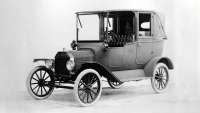What is the average height of a car?
The average height of a car is 1.8 metres.
That figure comes from averaging the height of popular vehicle types spanning the Australian new car market.
The average height of a small/compact SUV is about 1550mm, the average height of a medium SUV is about 1750mm, the average height of a large SUV is about 1800mm, the average height of an upper large SUV is about 1850mm, the average height of a ute is about 1850mm, and the average height of a US pick-up is about 2000mm.
The height of your car is a crucial factor in determining if you can safely house it undercover when you’re not driving it.
Also, when you’re out and about, the heights of undercover car parks may vary and you really don’t want to scrape the roof of your car – or worse – as you drive into one of those car park infrastructures.
One of the most important factors you must take into account when buying a car is whether it will fit in the allocated place in which you plan to park it or house it when it’s not being used – whether that be a resident-only car park, your driveway, an undercover garage, a car port etc. And, of course, a vehicle’s height is part of this concern.
_0.jpg)
So, how tall are cars? Whether you’re buying a hatchback, a sedan, a wagon or a full-size US pick-up, you must know the dimensions of your potential purchase in order to ensure you’re able to safely house it at your home.
Car heights differ depending on the vehicle type, for instance a Hyundai i30 (with a listed height “from 1415mm”, from CarsGuide) is not anywhere near as tall as a Ram 1500 pick-up (with a listed height “from 1917 mm”).
Note: for the purposes of this yarn, we’re focussing on the height of commercially available mainstream passenger vehicles.
So, what is the average car height? Read on.
.jpg)
How and why does the height of a car differ?
Car height within the same realm – hatchbacks, sedans, wagons, SUVs, utes, pick-ups etc – does not vary as greatly as something like length may.
How much do vehicles differ? Not a whole lot, really.
Unmodified models in the same section of the market will likely be within 150mm of each other in terms of height, from the ground to the top of the vehicle.
But remember, for accessorised/modified new or second-hand vehicles, to take into account taller-than-standard aerials, as well as gear like roof racks, luggage platforms, roof-top tents and the like.
.jpg)
Reckon I’m off the mark? Good for you. Feel free to push back in the comments section.
A small urban car – perhaps well suited to a couple or a couple and their anxious Shih Tzu, Tarquin – will need less space for people and/or cargo than a gargantuan, bush-based, horse-trailer-towing US pick-up that regularly carries five people in the cab (and two dogs in the tub).
So, it’s logical the city runabout vehicle will take up less physical space – and so offer less room – than something like an outback load-lugger.
But generally speaking, cars within the same realm – hatchbacks, sedans, wagons, SUVs, utes, pick-ups – will have similar measurements.
.jpg)
Is there an advantage to having a tall or low car?
Of course there is – and which one you prefer boils down to your lifestyle and specific vehicular needs.
The main advantage of having a lower/shorter car is its ease of parking in urban areas.
For your reference, the maximum height of an undercover parking building is usually listed as 2.0m or so on signage at the entrance to the structure.
.jpg)
If you’re in a small car, you’ll never suffer through those last-second white-knuckled doubts about whether your vehicle will actually fit into an undercover garage at the exact moment you’re about to drive into it.
The main advantage of having a taller car (wagon, van, ute) is the fact that its extra height likely means it has more interior room and cargo space, meaning it has greater capacity to carry people- and/or cargo in relative comfort than a smaller vehicle.
What is the average height of cars?
In Australia we use the metric system of measurement. In this feature, we’re referring to a car height in millimetres, which is a standard specification measurement in the vehicular world.
So, if you’re looking for the average height of a car in metres, feet or centimetres, then – tough luck – you’ll just have to work it out in your head.
For reference, the Federal Chamber of Automotive Industries (FCAI) defines selected vehicle types on their footprint (defined as length [mm] x width [mm], rounded).
This is a more considered way of calculating how much space a vehicle occupies, rather than merely thinking about only its height, or length, or width.
First up, micro, light or small cars* – we’re talking about vehicles such as Kia Picanto, Suzuki Ignis, Toyota Yaris, Hyundai Kona and the like.
.jpg)
(* Micro: “Hatch, sedan or wagon with a footprint < 6300mm”; Light: “Hatch, sedan or wagon with a footprint range 6301-7500mm”; or Small: “Hatch, sedan or wagon with a footprint range 7501-8300mm”, according to FCAI.)
For reference, the VW Polo is listed as “from 1442mm” high, according to our dimension experts here at carsguide.com.au – and we reckon the average height of a micro, light or small car falls somewhere between 1438mm (2022 VW Polo) and 1720mm (the Suzuki Jimny).
The average small/compact SUV (with a length (mm) x width (mm) less than 8100mm), is about 1535mm (Mazda CX-3) to 1640mm high (Mitsubishi ASX).
Let’s jump to medium SUVs – (with a FCAI-defined footprint of 8101mm-8800mm) – which includes vehicles such as Kia Sportage, Mazda CX-5, Mitsubishi Outlander, Toyota RAV4, Nissan X-Trail, Volkswagen Tiguan etc.
These vehicles are referred to as “medium” or “mid-size” and may have five or seven seats.

The average height of a medium SUV falls somewhere between 1700mm and 1800mm.
Large SUVs can carry up to seven people; upper large SUVs are able to carry up to eight passengers.
The average height of a large SUV (with an FCAI-listed footprint of between 8801mm and 9800mm) such as Toyota Prado, Land Rover Discovery and their ilk, falls somewhere between 1717mm (VW Touareg, as listed by CarsGuide) and 1842mm (Ford Everest, as noted by CarsGuide).
Upper large SUVs have an FCAI-defined footprint bigger than 9801mm. Think Audi Q7 (1781mm high), BMW X7 (1835mm high) through to Toyota LandCruiser 300 Series (1950mm high), etc.
Utes are classified as light trucks, which are “Vehicles designed principally for commercial but may include designs intended for non-commercial applications”.
.jpg)
They’re available as two-wheel drive (4x2) or four-wheel drive (4x4) vehicles, and as a cab chassis or with a tub at the rear.
These vehicles can legally carry up to five people in the cabin, depending on the body type, and have a FCAI-defined footprint of between 9001mm and 9501mm.
The average height of a ute available in Australia falls somewhere between 1750mm (Toyota HiLux, as listed by CarsGuide) and 1970mm (Toyota LandCruiser 79 Series WorkMate single-cab cab-chassis, as listed by CarsGuide).
Pick-ups are just like utes, but hardcore utes that have have taken a lot of steroids – we’re talking about the likes of the Ram 1500, the Ram 2500, the Chevrolet Silverado, the Ford F-150 etc.
The average height of these vehicles is about 1920mm, with pick-ups ranging from 1963mm high (Chevrolet Silverado, as listed by CarsGuide) to 2037mm high (Ram 3500, as listed by CarsGuide).
.jpg)
What are the tallest and lowest vehicles available in Australia?
The shortest commercially available new vehicle in Australia we reckon has to be something in the realm of the VW Polo, which has a listed height as “from 1442mm”.
There are plenty of tall heavy-duty work vans and utes available in Australia, but probably the tallest mainstream vehicle in Australia is the Toyota LandCruiser 78 Series Troop Carrier at a listed 2115mm high.
How to find out the height of a particular vehicle
If you’re reading this yarn on the CarsGuide website – and not on some dodgy website that has “curated” (read: stolen) our content and is pretending it’s their own – then look up at the menu bar at the top of the page and tap ‘Pricing and Specs’. That will take you, yes, to the ‘Pricing and Specs’ section.
Also, feel free to visit the appropriate carmaker’s website and download any specification sheets that are relevant to your particular choice of vehicle. Make sure you look at the correct make-model-variant details.





.jpg)
.jpg)



.jpg)
.jpg)

.jpg)

.jpg)


.jpg)



.jpg)




